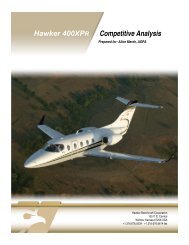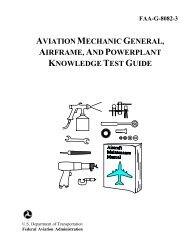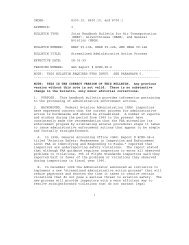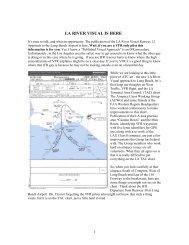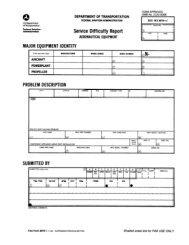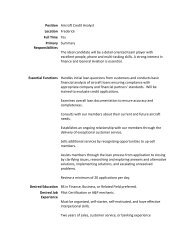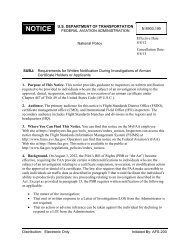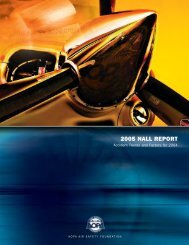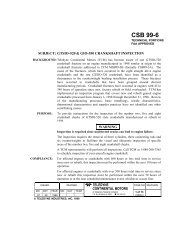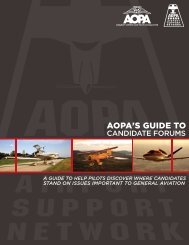2008 Nall Report - Aircraft Owners and Pilots Association
2008 Nall Report - Aircraft Owners and Pilots Association
2008 Nall Report - Aircraft Owners and Pilots Association
Create successful ePaper yourself
Turn your PDF publications into a flip-book with our unique Google optimized e-Paper software.
ACCIDENT FACTORS: HIGH-RISK PHASES OF FLIGHT<br />
Type of Operation<br />
Aerial application flights accounted for about 7<br />
percent of all GA flight time but 24.2 percent of<br />
maneuvering accidents. However, less than onethird<br />
of those proved fatal (Figure 30). About<br />
half of all maneuvering accidents in other types of<br />
working flights (including instruction) were fatal (9<br />
of 17), while more than two-thirds of those on personal<br />
flights caused at least one death.<br />
Purpose of Maneuvering Accident Flights<br />
All Accidents Fatal Accidents<br />
Personal 49 (53.8%) 33 (64.7%)<br />
Aerial application 22 (24.2%) 7 (13.7%)<br />
Instruction 4 (4.4%) 2 (3.9%)<br />
Other aerial work 13 (14.3%) 7 (13.7%)<br />
Business, positioning,<br />
<strong>and</strong> test flights 3 (3.3%) 2 (3.9%)<br />
Figure 30<br />
Flight Conditions<br />
Most maneuvering crashes (84.6 percent) occurred<br />
in daytime VMC (Figure 31). Only four took place<br />
in IMC <strong>and</strong> ten at night. However, 11 of 14 (78.6<br />
percent) maneuvering accidents that occurred<br />
at night or in IMC were fatal, compared to 51.9<br />
percent of those that occurred in VMC during daylight<br />
(40 of 77).<br />
Flight Conditions During Maneuvering<br />
Accidents<br />
All Accidents Fatal Accidents<br />
Day VMC 77 (84.6%) 40 (78.4%)<br />
Night VMC 10 (11.0%) 7 (13.8%)<br />
Day IMC 4 (4.4%) 4 (7.8%)<br />
Figure 31<br />
Accident Case Study<br />
LAX07FA160<br />
Diamond DA-40, Lake Pleasant, Arizona<br />
Two fatalities<br />
History of Flight<br />
The pilot telephoned an acquaintance who was boating on a<br />
lake, <strong>and</strong> informed him that he planned to overfly the lake. At<br />
the end of the evening’s civil twilight, witnesses observed the<br />
airplane approach the lake. The pilot telephoned the acquaintance<br />
<strong>and</strong> asked him to shine a light toward the airplane to<br />
facilitate being located on the lake. Other recreational boaters<br />
in the vicinity reported observing the airplane perform low<br />
altitude maneuvers, including a steep pull-up <strong>and</strong> a 70-degree<br />
angle bank. Witnesses estimated that some maneuvers were<br />
performed within a wingspan or two above the lake. The witnesses<br />
said the engine was not sputtering <strong>and</strong> sounded “real<br />
strong.” During one of the buzzing maneuvers, the airplane<br />
descended into the lake, fragmented, <strong>and</strong> sank. The accident<br />
occurred minutes after the end of civil twilight with a marginally<br />
visible horizon. A majority of the wreckage, including the<br />
engine, was not recovered.<br />
Pilot Information<br />
The pilot, age 45, held an airline transport pilot certificate<br />
for multiengine airplanes <strong>and</strong> a commercial certificate for<br />
single-engine airplanes. He was type-rated in the Cessna<br />
500 Citation <strong>and</strong> Shorts SD-3. Of at least 9,700 hours of<br />
total flight experience, 2,100 were in single-engine airplanes.<br />
His time in type was not reported.<br />
Weather<br />
The sky was clear, with 10 statute miles visibility <strong>and</strong> winds<br />
from 290 degrees at 3 knots.<br />
Probable Cause<br />
The pilot’s failure to maintain sufficient altitude above the<br />
surface of water during an intentional buzzing maneuver.<br />
Contributing to the accident was the nighttime lighting<br />
environment.<br />
ASF Comments<br />
Buzzing is always a high-risk maneuver <strong>and</strong> should be avoided.<br />
Adding reduced visibility in the dark <strong>and</strong> lack of visual<br />
references while flying over water made this crash almost<br />
inevitable.<br />
21



